|
We had just gone to our tent when the hyenas came. Suddenly
the night was pierced by unbelievably loud high-pitched whooping
noises and shrieks of maniacal laughter. I had never heard
anything like it before, but I knew immediately, unmistakably,
that it was hyenas. I had always vaguely wondered why they called
them ‘laughing hyenas’, as the soft whoops and calls I was
accustomed to hearing from them did not sound like laughter at
all. But this did - like incredibly loud hysterical laughter from
some deranged insane asylum escapee! Chills went down my spine.
I grabbed my headlamp and went out the front of the tent,
scanning the darkness, seeking the source of those bone chilling
cries; Jineen was right behind me. We shined our lights into the
night, searching. Suddenly I saw glowing eyes, just outside the
light of the lanterns; five or six pairs, staring back at me
intently. Whoa! OK, I think it is time
to go back in the tent now. We retreated back inside the
canvas, peering out the thin mesh door.
Two hyenas walked right into camp as if they owned it. They
let out their haunting cries again as they squabbled, walking
right between our tent and Patty’s. Perhaps they were arguing
over which of us to eat first? We leaned out the tent flap,
awestruck. They were huge! Second in size only to the lions among
the predators of Africa, the hyenas have powerful jaws that can
crack elephant bones. When looking down at hyenas from the safety
of the Landcruiser they had seemed imposing enough - but seeing
them at eye level from less than fifty feet away was a completely
different experience. And listening to their terrifying shrieks
and cries was not something I would forget any time soon.
About that time Gee pulled the Landcruiser up into the
middle of camp and turned the headlights on; the hyenas stood
frozen in the glaring light for a few moments, and then
disappeared back into the night. Gee’s voice came floating
through camp; “That was amazing!”
I
write this journal, in part, to try to share the wonder of going
on safari in Africa. You can’t really explain what it is like to
someone who hasn’t been there. You cannot sufficiently describe
the spectacular and amazing diversity of the landscape and
wildlife, and the glorious, beautiful and often cruel circle of
life. Yet I feel compelled to try.
But
the greater reason I write this is for more selfish reasons; I
want to be able to relive the trip, and to have a record to help
me remember every detail. As I go over my notes and look at the
photos, I am reliving a thousand magic moments that had already
slipped my mind, even though only a few months have passed. So I
am recording as much detail as I can remember in order to be able
to enjoy the trip for years to come. For most of you who were not
there this narrative may seem boring, but perhaps there might be a
few readers out there who take as much delight in wildlife and
nature as I do, who find some interest in the details of these
pages. For the rest of you, I apologize in advance for boring you.
July 15
At last we were off! My friend Jineen and I were on our way
to northern Botswana. We had last visited southern Africa in 2015,
and had been looking forward to returning ever since.
It is always a bit of a dilemma;
do you go back to a place you have been before and loved, or do
you go somewhere new? I like to do some of both; if you return to
an area you can really get to know it and make it your own – but
of course you want to see new places as well. We booked through
the Scott Dunn travel company for an extended version of the
Letaka mobile camping safari we had done in 2015, and added a
short stay at Camp Kalahari at the Makgadikgadi
saltpans at the end of the trip for a change of scenery. In
addition to Jineen and myself, our group for this trip included my
sister Patty and her husband Rob, and friends Paula, Natalie and
Tara.
After
a hectic week getting everything caught up on the farm in
preparation for being gone for almost three weeks, we were happy
to finally be on our way. Jineen and I flew out of Dulles on
Ethiopian Air, business class courtesy of frequent flier miles.
Flying first class is enough of a novelty to me that I really
don’t mind the long flights; it was 13 hours to Addis Ababa in
Ethiopia, and another six to Johannesburg. Seats that turn into
flat beds, our own private movie screens, great service, an
excellent selection of traditional Ethiopian foods and free
alcohol. Life was good.
Looking out the window as we approached Addis Ababa, we could see
a patchwork of crop fields below in a variety of rich earth-tone
colors. We had a layover of several hours which we spent in the Cloud
Nine first class lounge. We enjoyed the international flavor
of the airport; many of the destinations on the flight board were
so exotic that we didn’t even recognize the alphabet.
|
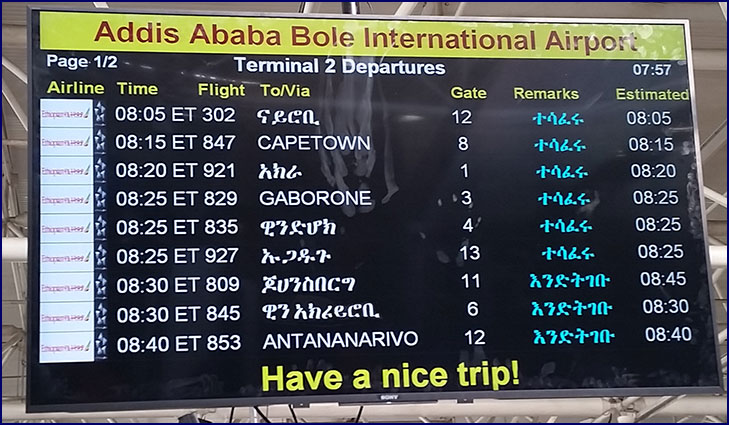
Changing planes in
Addis Ababa
|
July
16
Flying across Africa on our way to Johannesburg, I was
mesmerized by the vast expanse of barren brown desert rolling
beneath the window. Does anyone live there? Endless sand, low
hills, sparse trees and dry riverbeds, punctuated by a few sharp
ridges. I could see Mount Kilimanjaro in the distance, shrouded by
cloud.
In
Johannesburg, we were picked up by a driver and taken to the
Sunrock Lodge. This was a comfortable small lodge close to the
airport where we were to spend the next two nights. We met up with
Paula at the Sunrock that evening, and went to the bar for a
drink. We played a scavenger hunt type game of locating 14 little
yellow Gumby-like toys hidden around the bar. We had a nice
dinner, and then exhausted from the long trip, it was early to
bed.
July 17
The next morning a private guide
took Jineen, Paula and me for a tour of Constitution Hill and the
Apartheid Museum. Driving through the busy streets, we were amazed
at the number of people walking in the roads in dangerous traffic
– we were expecting to see people run over at any moment. We
passed a statue of George Harrison (not the Beatle); our guide
told us he was the one who had ‘started all the trouble’ by
discovering gold near Johannesburg, leading to everyone fighting
over it.
Constitution Hill is the site of a
former military fort that later became a prison, where activists
opposed to Apartheid were imprisoned along with criminals. It was
a place of extreme injustice, and the conditions in which the
prisoners were kept, especially the black ones, were beyond
belief. People were often held in prison for up to seven years
before even being tried and sentenced. The cells were extremely
overcrowded, and the food was horrible and scarce. The prisoners
were strip-searched, humiliated, starved, whipped, and sometimes
beaten to death. We were shocked to find that these abhorrent
practices had continued until as recently as the mid-1980s.
We
learned about the horror of Apartheid. Non-whites had no rights,
and had to live apart from the whites in horrible slums. They
could only enter the city if they had special passes proving they
had a job; if they were caught in the city without a pass they
were thrown in to the prison.
|
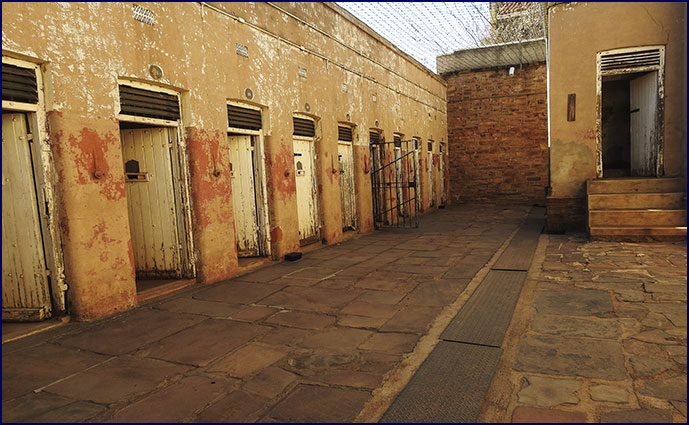
The prison at Constitution
Hill
|
There were signs and displays giving info about the
atrocious conditions and cruel treatment of the prisoners. Sixty
or more people would be crammed in to each small cell, with
nothing except a thin blanket between them and the cold stone
floor. It was sweltering hot in the summer with little
ventilation, and freezing cold in winter. We toured the dark tiny
solitary confinement cells, saw the whipping posts, and gazed at
the rolls of barbed wire atop the walls. Prisoners sometimes did
art projects to keep themselves occupied; we saw an elaborate tank
built from folded and rolled-up towels and blankets - my guess is
it was dismantled in winter when they needed the blankets.
After
Apartheid came to an end in the mid-1990s, The Constitutional
Court was built on the site of the former prison. This is the
highest court in the land, equivalent to the Supreme Court in the
USA. Our guide explained to us that much symbolism was used when
building the court. The walls were built using the bricks of the
prison. The words Constitution
Court are written
on the outside of the building in the eleven official languages of
the country. There are wooden carvings around the door depicting
the 27 human rights. There is a beautiful round sign on the door
displaying a tree of justice.
|
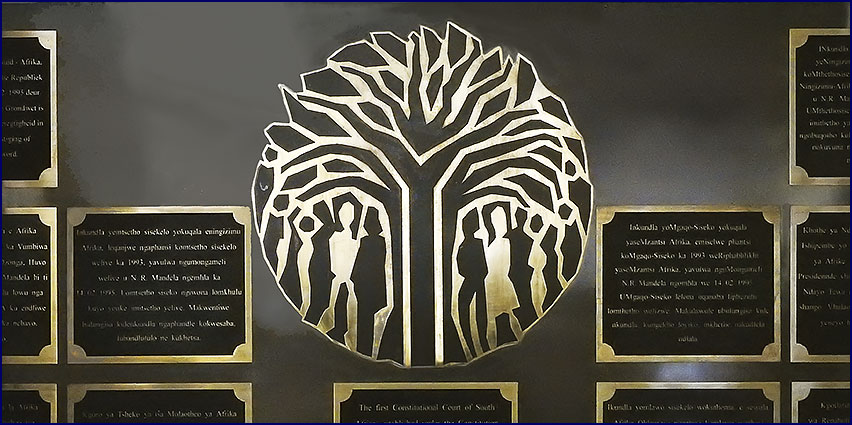
The Tree of Justice
|
Inside all of the seats are leather, and they are at the
same height for both the justices and the public, signifying that
everyone is sitting equally. Only the press sits in an elevated
position, as they are responsible for keeping the people informed.
The windows around the court represent transparency, but they are
placed low, where from inside one can only see the feet and legs
of the people outside; that way they are seen not by race or
gender, but merely as people. There are variegated black and white
cow hides on the railings from a breed of cattle found only in
South Africa, signifying that the two races have unity while each
keeps its unique patterns. An intricate tapestry hangs in the
court, containing the South African flag, the tree of justice with
11 trunks for the 11 tribes and 11 justices, and a flower in
flames symbolizing that sometimes things have to burn in order to
make things better. As depressing as the prison was, my impression
of the court was uplifting, filled with hope for the future.
|
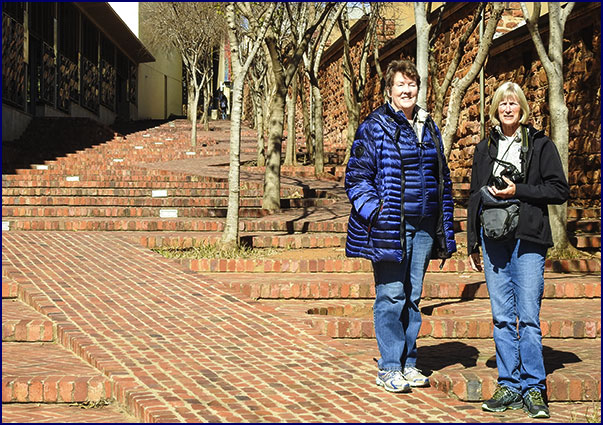
The Path to the Future
|
Outside there was a winding stairway built from the prison
bricks; our guide told us it symbolized ‘the bricks from the
past paving the path to the future.’ At the bottom of the
staircase stood an impressive and somewhat disturbing statue of a
creature that appeared to be half man and half crocodile; we never
did find out what it meant. There were silhouettes of people like
long shadows embossed in the sidewalk. By the door was another
depressing statue of a man harnessed to a cart; the meaning of
this one was clear - the yoke of slavery and oppression.
|
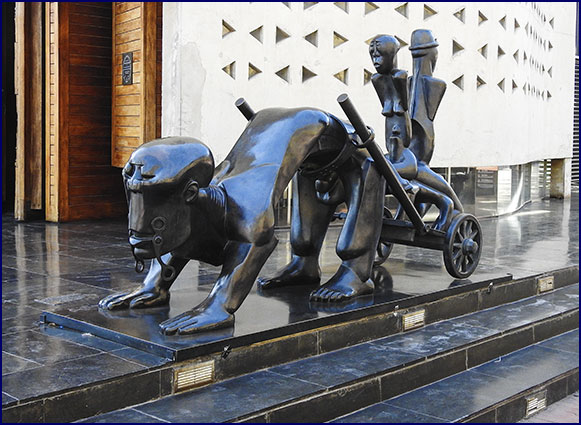
The Yoke of Slavery
|
Next
we went to the Apartheid Museum, which was a really remarkable
experience. We followed the maze of hallways filled with displays
of photos and text, learning about the life and career of Nelson
Mandela and his fight against Apartheid. He was imprisoned for 27
years, from 1962 to 1990, and became president after his release
at the age of 75. He died in 2013. We enjoyed learning more about
this great man and his fight for freedom and equality for all
people.
We had a little trouble following the
displays chronologically; at times we could not tell what order
the displays were in and what came next. It was only when we were
in the last room of the tour did we realize that the pamphlet we
had been given with our tickets included a map.
Outside, there was a display of
large mosaic-like glass signs in different colors, each with a
different Nelson Mandela quote. A sign instructed us to each
decide which quote we found most inspiring and then to choose a
stick of that color and place it in a special rack; all the colors
were represented about equally. My favorite was “I
learnt that courage was not the absence of fear, but the triumph
over it. The brave man is not he who does not feel afraid, but he
who conquers that fear.”
Paula had been in Johannesburg for a couple of days before
our arrival, and she had discovered a nice bird exhibition at a
nearby casino. After completing our half-day tour we took an uber
to go visit it. It had
a huge aviary that one could walk through and see dozens of
different species; among others we saw parrots, pelicans,
flamingos, ducks and cranes from all over the world. There were
tiny deer-like duikers, scarlet ibis, golden pheasants, and
ring-tailed lemurs. While I do not believe wild animals and birds
belong in cages, it was a very good exhibit which lets the general
public have access to these beautiful creatures and raises
awareness of the need for conservation.
Back at the Sunrock, we met up
with Patty, Rob and Natalie for dinner. Paula is a veterinarian
and Rob an emergency room doctor, so we figured we had any medical
needs covered! We were only missing Tara, who was scheduled to
arrive at the airport in the morning.
July
18
After
breakfast at the Sunrock the shuttle took us to the airport.
Looking through the shops I found a baby cheetah stuffed animal
that I couldn’t resist buying - I named him Duma. Paula bought
an excellent stuffed bushbaby which she called Fred. They would be
our trip mascots.
It was time for our flight to Maun,
Botswana. Tara was still not there; we knew her connection had
been extremely tight - at the last possible minute we saw her
running down the escalator to the gate. Our group was now
complete.
In
Maun the airport was hot and crowded, and the line for customs and
immigration was long. Once through, we met up with the pilot from
Mack Air for our charter flight to Savuti, in Chobe National Park.
It was a relief when we finally got on the small plane.
We
had a birds-eye view of the Okavango Delta, with its wide expanses
of water and flooded plains. Fed by seasonal rains from Angola a
thousand miles to the north, the Delta’s blue water stretched
out below us, interspersed with green marshes and sun-bleached
plains. It was a beautiful blue-green landscape, like photos of
earth from space. Our little plane stopped at two other airstrips
to drop off passengers along the way; we could glimpse elephants
in the water as we flew over, and make out a few giraffes and
zebras far below. At Khwai, the second stop, a herd of impala were
grazing on the runway, and the pilot had to buzz them with a low
pass to scare them off before circling around for a landing.
|
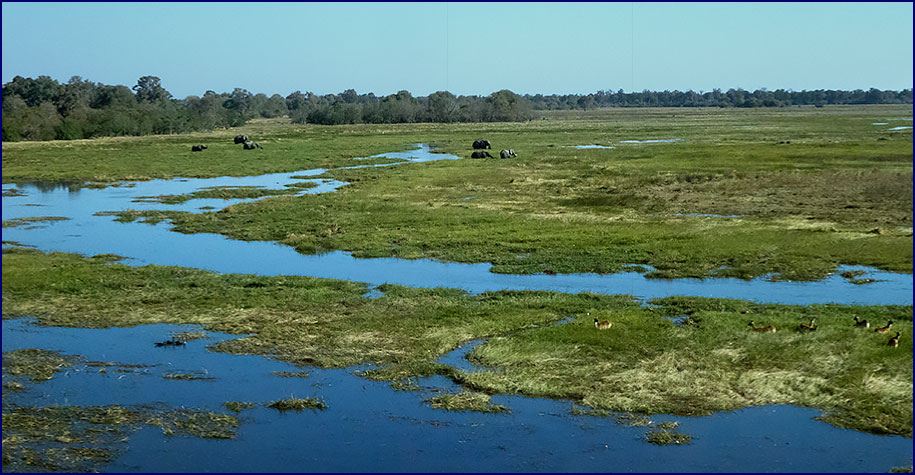
Landing
in the Okavango Delta |
Our guide, Gee Mange (pronounced Mang-ee), was waiting for
us when we landed on the dirt airstrip at Savuti. Jineen and I had
been on safari with Gee on our previous trip, and we were really
happy to be going with him again. I got a little choked up when I
saw him standing there, leaning against the Letaka safari vehicle,
just like we had last seen him when we left in 2015.
Gee greeted us, then loaded our
luggage into a small trailer on the back of the Toyota Landcruiser.
We all piled into the vehicle and Gee straightaway took us to see
some giraffes that were not far from the runway. One of these tall
graceful creatures crossed the road right in front of us, walking
with long slow elegant strides. Wow, we were about 30 seconds into
our safari and already had our first major wildlife sighting!
Then Gee stopped and introduced himself to the rest of the
group, and everyone seemed to hit it off well immediately.
It took Gee about an hour to drive from the airstrip to our
camp. On the way we saw impalas, giraffes and wildebeests. There
were plenty of birds to greet us, including the abundant
francolins and spurfowl, both red-billed and yellow-billed
hornbills, a magpie shrike, and a kori bustard. The sun lowered in
the sky as we drove on in the fading light. A mongoose crossed the
road in front of us, and an elephant walked quietly through the
dusk.
Gee stopped the Landcruiser
briefly and we watched the sun go down. A herd of wildebeests
crossed the bushveld in front of us, silhouetted against the
sunset. A fiery sky bathed the scene in golden light. Those in our
group who had not been on safari before were wide-eyed, but for
Jineen and me it all fit like a well-worn glove. The bush, the
wildlife, the Landcruiser, driving with Gee; it felt like coming
home.
|
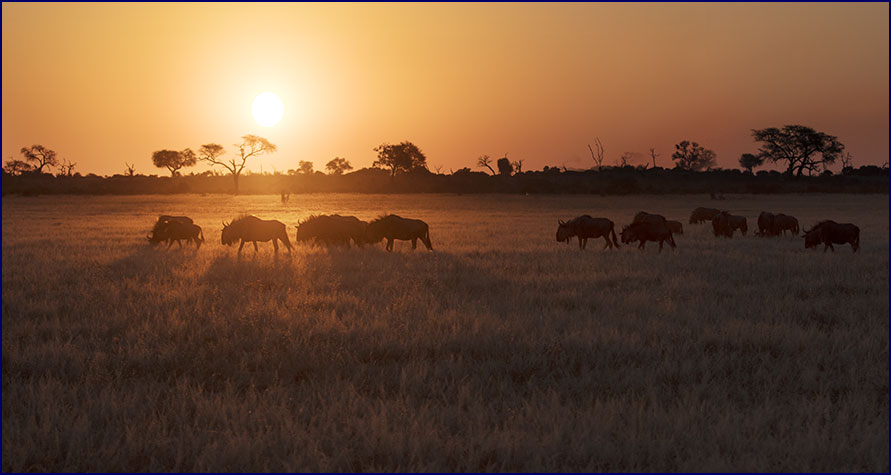
Sunset
with the Wildebeests |
Traveling to Africa and seeing the wildlife is always
incredible, and each time we have gone Jineen and I have been just
blown away by it - the thrill never wears off. Patty and Rob had
been once before as well. But Paula, Natalie and Tara had never
visited Africa before, so we were seeing it fresh through their
eyes. They were absolutely amazed at the amount of wildlife we
encountered; Tara said we had seen as much in an hour as she had
expected to see in a week! We were off to a good start.
We arrived at camp; it was the
exact same campsite Jineen and I had stayed at last time, right
beside a dry riverbed. A rocky hill rose on the other side of the
river, and a dead tree was silhouetted against the pastel sunset
sky, serving as a perch for birds of prey. There were five tents
in a semicircle, with lanterns lighting the way to them.
|
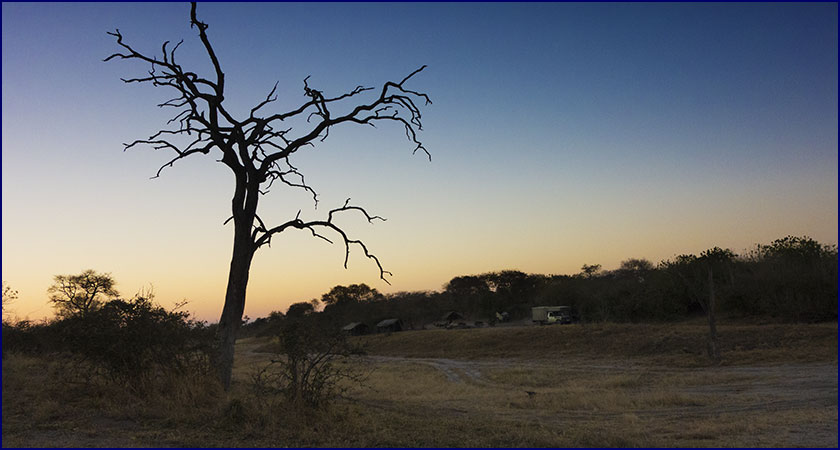
Our
camp at Savuti |
The tent Jineen and I shared was closest to the riverbed.
It had a canvas floor, mesh windows, and a zippered door flap.
There were two camp beds, each with a tiny folding bedside table.
At the front of the tent there was an overhang that formed a small
verandah, with two folding camp chairs and two canvas basins for
washing our hands. At the back of the tent was a canvas enclosure
with a bucket shower, and a toilet seat situated over a deep-drop
hole - a bucket of ashes sat nearby to be used for ‘flushing.’
The toilet paper was kept inside the tent in case of
monkeys.
After a brief visit to our tents
we came out to the campfire, and Gee introduced us to the rest of
the staff. Pula was our chef, Phillimon was our waiter, and our
general camp helper was Parker.
As we sat around the fire, the
blue and rose and mauve sky faded to a velvety black, and the
stars came out in force. With no moon to cast ambient light, the
night sky was a celestial show without rival. Scorpio hung high
overhead, and the Southern Cross shone brightly above the river
bed. The Milky Way
stretched across the sky and all the way down to the horizon, its
magnificent grandeur making us feel small and insignificant.
Gee told us about his childhood, growing up on an island in
the Okavango Delta. His real name is Gaeboelwe, but at least on
safari he goes by Gee. He learned at a very young age how to track
animals and survive in the bush. His family sent him to live with
his aunt in Maun while he attended school there, but she was mean
and starved him, not giving him enough to eat even though his
family sent food and money. Eventually he could not stand living
with her anymore, so he left school and went back home. He later
went to Guiding school and earned Grade 3, the highest rating,
which is required to guide for camping safaris. Gee is of the
Bayei tribe. He speaks three languages, Setswana, Bayei, and
English.
Pula announced dinner, standing
formally by the fire and telling us what each course would be. We
went to the table, beautifully set under a tent canopy. The food,
all cooked in camp, was excellent; it is unbelievable what these
guys can cook over a fire or with a camp stove. Gee told us that
any leftover food is thrown into the fire and burned so as not to
attract scavengers.
As we were eating, a large brown
insect over an inch long landed on the table and buzzed around a
bit. Gee said it was a driver ant, and we watched it with
interest. Then it flew down my shirt.
After dinner we went back out to the campfire. I gave Gee a
gift I had made him; a talisman of beads and stones, hopefully
imbued with some Windchase Magic from home. I told him it should
bring him good fortune and luck. We headed to the tents about ten
o'clock. Shivering a bit in the cold winter air, I was delighted
to find a hot water bottle tucked away in my bed; it kept me warm
and cozy all night.
One of my favorite things about
Africa is hearing the sounds of the animals in the night. I
didn’t sleep much; I was too eager to listen. I heard a faint
trilling noise and the rustling of something small, close to the
tent. Later I heard high-pitched voices going up and down the
riverbed. Was it spurfowl? Mongooses? I wasn’t sure, and never
did find out.
I
could hear hyenas as they passed through camp, their voices rising
and lowering in pitch as they communicated quietly with one
another. Later, there was a soft ascending whoop-whoop as a lone hyena called out for his friends. I shined the
flashlight out the window to try and see him but the mesh
reflected the light back. Several times in the night I heard a
harsh snorting sound not unlike the bark of a dog - probably the
alarm call of an impala or kudu.
Early in the morning, not
long before our wakeup call, I heard what sounded like the
grunting of a large pig near the tent. Was it a warthog? A bush
pig? At breakfast Gee
told us that it was the cough-like sound of a leopard; one had
been right in the camp during the wee hours of the morning.
July 19
Our
wakeup call came at five-thirty, a soft voice calling good morning outside our tent. The winter air was crisp and cold,
and we dressed in layers. There was coffee at the campfire, and a
simple breakfast of toast and oatmeal (known here as jungle oats) was served at six. Jineen told me she had dreamed that
I had left the tent in the night and was being chased by hyenas in
the deep dry sand of the riverbed.
We were on the road by 6:30,
heading out before it was fully light. We paused to watch the sun
come up, the sky a palette of purple and rose. The world was
peaceful, the quiet broken only by occasional birdsongs.
Right away we came upon a pair of lions, lying beside the
sandy road. They were magnificent. A big male with a blonde mane,
and a lithe tawny female. Gee said the female was starting into
estrus, and might be ready to breed by later that day. She stood
up, yawned and stretched, then walked about ten feet and lay down
again. The male did the same, marking his territory and looking
hopeful, but she wasn’t quite ready yet. This pattern was
repeated over and over.
Gee told us that these lions were members of the Marsh
Pride, and that the male was the same one I had seen and
photographed in 2015. I remembered that occasion, when I had taken
one of my favorite photos ever. My old friend. Will he still be
here next time I visit?
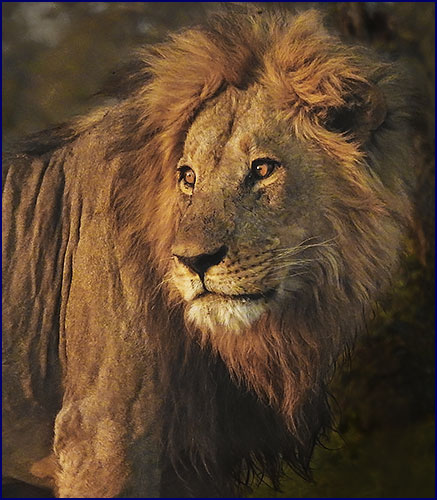
My friend from 2015 |
As we drove on through the bush, we saw lots of impalas -
graceful beautiful antelopes reminiscent of our white-tailed deer
in Virginia. The males have long backswept twisted horns. There
were many birds; the ubiquitous francolins and spurfowl were
everywhere, and red-billed hornbills flitted from tree to tree.
Before long we found more of the Marsh
Pride members; there were three lionesses and a couple of
half-grown youngsters by the carcass of an antelope they had
killed. They gnawed on the remains, the ribcage sticking up in the
air. One of the adolescent males got up and walked around carrying
an empty beer can in his mouth, no doubt discarded by some
careless tourist. Several vultures watched from the nearby trees,
waiting their turn at the carcass.
It is always amazing how the
animals take so little notice of people, as long as they stay in
the vehicle. Gee said they don’t see us as humans; they see us
and the Landcruiser as one entity, like a big harmless animal. On
the other hand, if we were to get out of the vehicle then the
lions would see us as people - they would either run away or kill
us, depending on their mood.
|